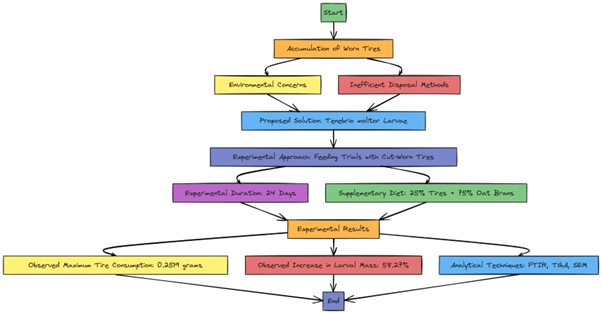Optimizing Tenebrio Molitor Feeding Strategy to Induce Physical Degradation of Tires: A Novel Approach for Sustainable Waste Management
Main Article Content
Abstract
Due to the increased usage of tires, the accumulation of worn tires has become a significant environmental concern and necessitates environmentally friendly waste management strategies. Conventional methods, such as tire incineration or improper disposal, contribute to environmental degradation. It is reported that organisms, such as Tenebrio molitor larvae, can degrade a wide range of polymers. This study explores the promising potential of Tenebrio molitor larvae in addressing this concern. Through a series of experiments, Tenebrio molitor larvae were fed with cut-worn tires to facilitate degradation. The larvae exhibited remarkable capabilities, surviving and thriving on tires as a sole carbon source for 24 days, with a maximum tire consumption of 0.2519 g observed. A significant 58.27% increase in larval mass was observed when a diet comprising 25% tires and 75% oat brans was provided. Analytical techniques, including FTIR, TGA, and SEM, successfully demonstrated the larvae's efficient consumption of tire materials. These findings highlight the potential of Tenebrio molitor larvae as an eco-friendly solution for tire disposal, offering insights into sustainable waste management practices.
Article Details

This work is licensed under a Creative Commons Attribution-NonCommercial 4.0 International License.
Published articles are under the copyright of the Applied Environmental Research effective when the article is accepted for publication thus granting Applied Environmental Research all rights for the work so that both parties may be protected from the consequences of unauthorized use. Partially or totally publication of an article elsewhere is possible only after the consent from the editors.
References
IRSG, “International rubber study group,” 2016. Accessed: May 03, 2023. [Online]. Available: http://www.rubberstudy.com/news-article.aspx?id=5106&b=default.aspx
T. Amari, N. J. Themelis, and I. K. Wernick, “Resource recovery from used rubber tires,” Resources Policy, vol. 25, no. 3, pp. 179–188, Sep. 1999, doi: 10.1016/S0301-4207(99)00025-2.
M. A. Ghowsi and M. Jamshidi, “Recycling waste nitrile rubber (NBR) and improving mechanical properties of Re-vulcanized rubber by an efficient chemo-mechanical devulcanization,” Advanced Industrial and Engineering Polymer Research, vol. 6, no. 3, pp. 255–264, Jul. 2023, doi: 10.1016/j.aiepr.2023.01.004.
A. M. Moasas et al., “A worldwide development in the accumulation of waste tires and its utilization in concrete as a sustainable construction material: A review,” Case Studies in Construction Materials, vol. 17, p. e01677, Dec. 2022, doi: 10.1016/j.cscm.2022.e01677.
K. Formela, “Waste tire rubber-based materials: Processing, performance properties and development strategies,” Advanced Industrial and Engineering Polymer Research, vol. 5, no. 4, pp. 234–247, Oct. 2022, doi: 10.1016/j.aiepr.2022.06.003.
H. P. S. Makkar, G. Tran, V. Heuzé, and P. Ankers, “State-of-the-art on use of insects as animal feed,” Anim Feed Sci Technol, vol. 197, pp. 1–33, Nov. 2014, doi: 10.1016/j.anifeedsci.2014.07.008.
K. Riaz et al., “Growth Optimization and Rearing of Mealworm (Tenebrio molitor L.) as a Sustainable Food Source,” Foods, vol. 12, no. 9, p. 1891, May 2023, doi: 10.3390/foods12091891.
B.-Y. Peng et al., “Biodegradation of Polyvinyl Chloride (PVC) in Tenebrio molitor (Coleoptera: Tenebrionidae) larvae,” Environ Int, vol. 145, p. 106106, Dec. 2020, doi: 10.1016/j.envint.2020.106106.
I. Jajić et al., “Changes in the chemical composition of the yellow mealworm (Tenebrio molitor L.) reared on different feedstuffs,” J Anim Feed Sci, vol. 31, no. 2, pp. 191–200, May 2022, doi: 10.22358/jafs/147848/2022.
A. M. Brandon et al., “Biodegradation of Polyethylene and Plastic Mixtures in Mealworms (Larvae of Tenebrio molitor ) and Effects on the Gut Microbiome,” Environ Sci Technol, vol. 52, no. 11, pp. 6526–6533, Jun. 2018, doi: 10.1021/acs.est.8b02301.
M. G. Aboelkheir, L. Y. Visconte, G. E. Oliveira, R. D. Toledo Filho, and F. G. Souza, “The biodegradative effect of Tenebrio molitor Linnaeus larvae on vulcanized SBR and tire crumb,” Science of The Total Environment, vol. 649, pp. 1075–1082, Feb. 2019, doi: 10.1016/j.scitotenv.2018.08.228.
S. S. Yang et al., “Biodegradation of polypropylene by yellow mealworms (Tenebrio molitor) and superworms (Zophobas atratus) via gut-microbe-dependent depolymerization,” Science of the Total Environment, vol. 756, Feb. 2021, doi: 10.1016/j.scitotenv.2020.144087.
C. Loudon, “Development of Tenebrio molitor in low oxygen levels,” J Insect Physiol, vol. 34, no. 2, pp. 97–103, Jan. 1988, doi: 10.1016/0022-1910(88)90160-6.
J. Coates, “Interpretation of Infrared Spectra, A Practical Approach,” in Encyclopedia of Analytical Chemistry, Wiley, 2000. doi: 10.1002/9780470027318.a5606.
J. Wang et al., “Ingestion and biodegradation of disposable surgical masks by yellow mealworms Tenebrio molitor larvae: Differences in mask layers and effects on the larval gut microbiome,” Science of The Total Environment, vol. 904, p. 166808, Dec. 2023, doi: 10.1016/j.scitotenv.2023.166808.
